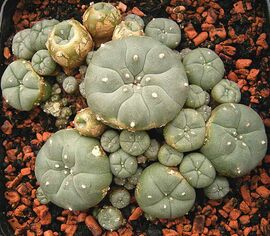This is an unofficial archive of PsychonautWiki as of 2025-08-11T15:14:44Z. Content on this page may be outdated, incomplete, or inaccurate. Please refer to the original page for the most up-to-date information.
Lophophora williamsii: Difference between revisions
Jump to navigation
Jump to search
>Kaylee No edit summary |
>White No edit summary |
||
| Line 1: | Line 1: | ||
{{stub}} | {{stub}} | ||
{{BotanyBox/Lophophora williamsii}} | {{BotanyBox/Lophophora williamsii}} | ||
'''Lophophora williamsii''' also knows as '''Peyote''' or '''Peyotel (Spanish)''' is a slow growing spineless cactus with psychoactive alkaloids like [[mescaline]].<ref>http://www.ncbi.nlm.nih.gov/pubmed/5065448</ref> Native North Americans are likely to have used peyote, often for spiritual purposes, for at least 5,500 years.<ref>El-Seedi HR, De Smet PA, Beck O, Possnert G, Bruhn JG (October 2005). "Prehistoric peyote use: alkaloid analysis and radiocarbon dating of archaeological specimens of Lophophora from Texas". J Ethnopharmacol.</ref> | '''Lophophora williamsii''' also knows as '''Peyote''' or '''Peyotel (Spanish)''' is a slow growing spineless cactus with psychoactive alkaloids like [[mescaline]] and [[pellotine]].<ref>http://www.ncbi.nlm.nih.gov/pubmed/5065448</ref> Native North Americans are likely to have used peyote, often for spiritual purposes, for at least 5,500 years.<ref>El-Seedi HR, De Smet PA, Beck O, Possnert G, Bruhn JG (October 2005). "Prehistoric peyote use: alkaloid analysis and radiocarbon dating of archaeological specimens of Lophophora from Texas". J Ethnopharmacol.</ref> | ||
== | ==Alkaloids in different Lophophora species== | ||
According to the study by Dr Štarha<ref>Grym, Rudolf (1997). Rod/Die Gattung Lophophora. Bratislava: Vydavateľstvo Roman Staník. ISBN 80-900933-9-6. [The book features an appendix on Lophophora chemistry by Dr Roman Štarha.]</ref> all varieties of peyote contain approximately 0.7 mg of mescaline per gram of living plant. Both Lophophora diffusa and Lophophora fricii are found to be low in mescaline and high in [[pellotine]]. | |||
Revision as of 05:26, 21 September 2016
 |
This article is a stub. As such, it may contain incomplete or wrong information. You can help by expanding it. |
| Lophophora williamsii | |
|---|---|
 Peyote in a pot. |
|
| Taxonomical nomenclature | |
| Kingdom | Plantae |
| Unranked | Angiosperms |
| Unranked | Eudicots |
| Unranked | Core eudicots |
| Order | Caryophyllales |
| Family | Cactaceae |
| Genus | Lophophora |
| Species | L. williamsii |
| Common nomenclature | |
| Common names | Peyote, Peyotel (in Latin America) |
| Constituents | |
| Active constituents | Mescaline, Pellotine, Hordenine, etc. |
Lophophora williamsii also knows as Peyote or Peyotel (Spanish) is a slow growing spineless cactus with psychoactive alkaloids like mescaline and pellotine.[1] Native North Americans are likely to have used peyote, often for spiritual purposes, for at least 5,500 years.[2]
Alkaloids in different Lophophora species
According to the study by Dr Štarha[3] all varieties of peyote contain approximately 0.7 mg of mescaline per gram of living plant. Both Lophophora diffusa and Lophophora fricii are found to be low in mescaline and high in pellotine.
External links
References
- ↑ http://www.ncbi.nlm.nih.gov/pubmed/5065448
- ↑ El-Seedi HR, De Smet PA, Beck O, Possnert G, Bruhn JG (October 2005). "Prehistoric peyote use: alkaloid analysis and radiocarbon dating of archaeological specimens of Lophophora from Texas". J Ethnopharmacol.
- ↑ Grym, Rudolf (1997). Rod/Die Gattung Lophophora. Bratislava: Vydavateľstvo Roman Staník. ISBN 80-900933-9-6. [The book features an appendix on Lophophora chemistry by Dr Roman Štarha.]